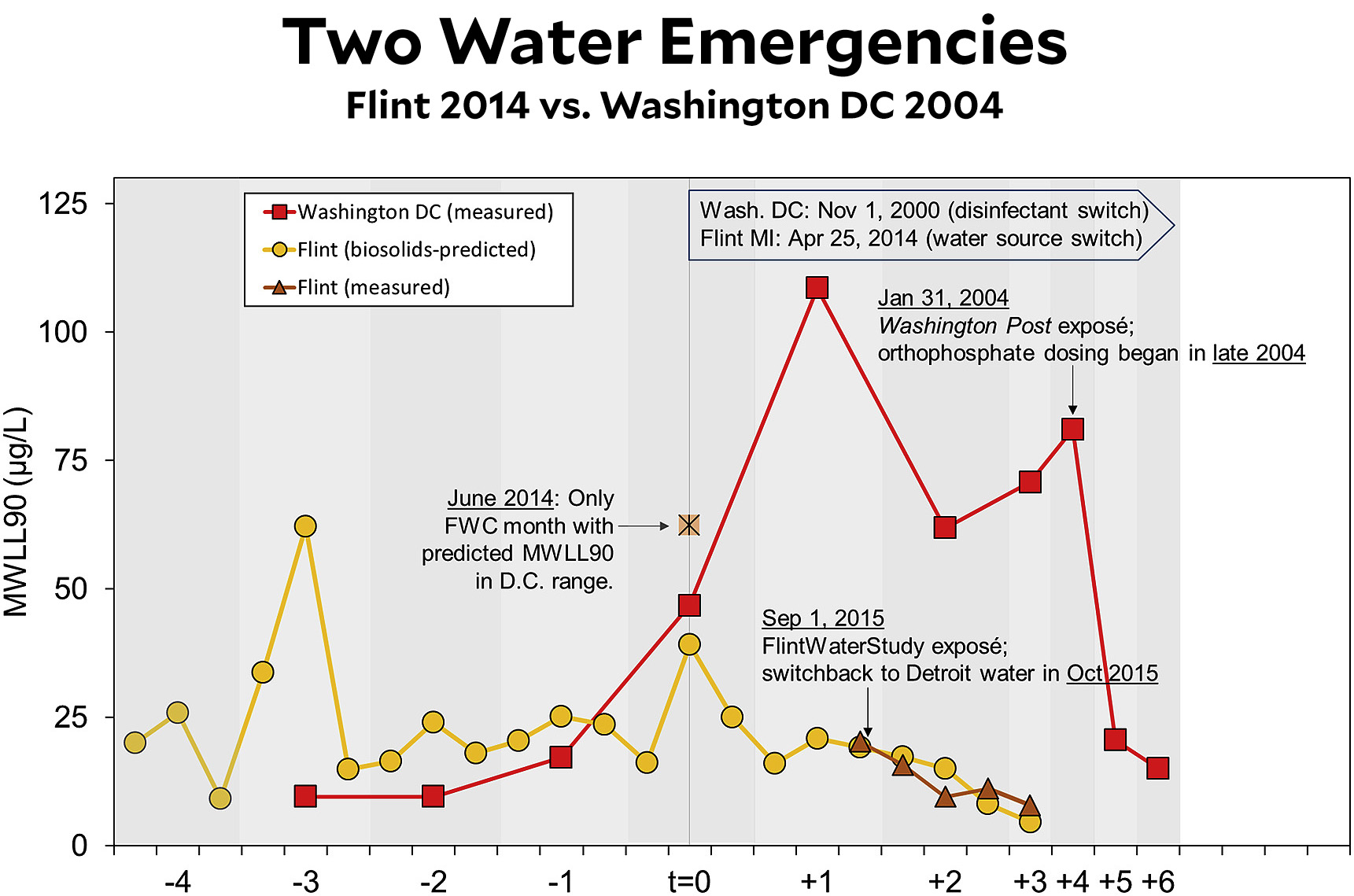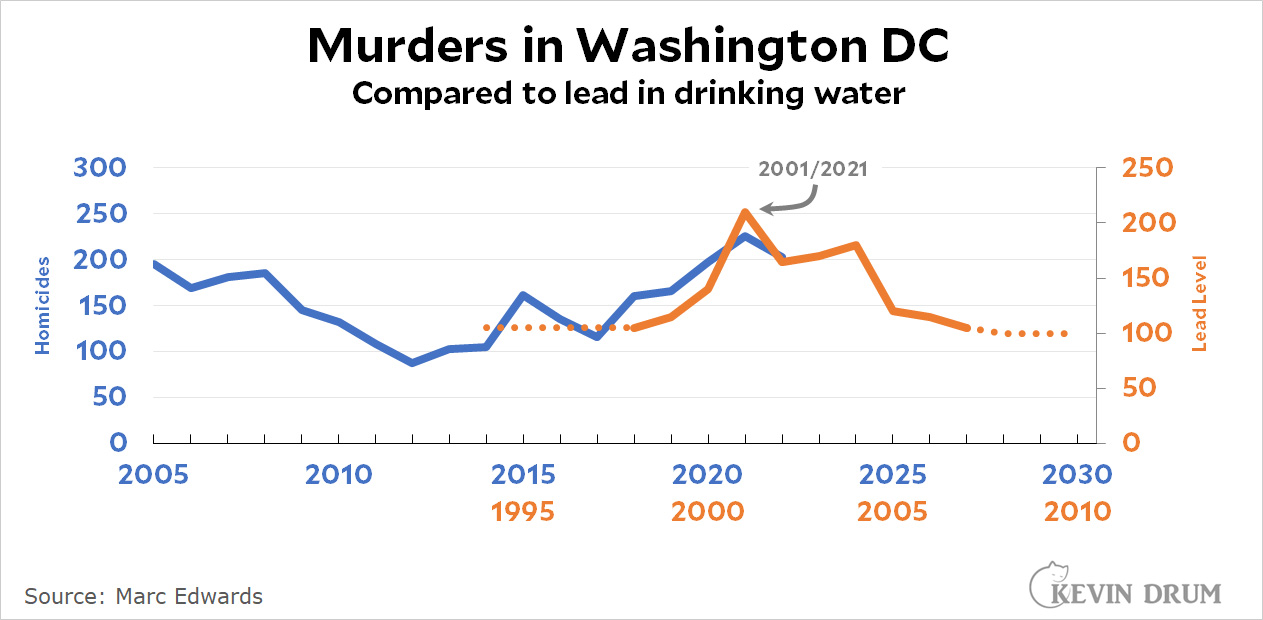Yesterday I ran across an item about the high murder rate in Washington DC. I also happened to remember this, based on the research of Marc Edwards:
 Beginning in the year 2000, Washington DC experienced an episode of lead contamination in its drinking water that wasn't discovered until 2004. For five years, DC's kids were drinking water with highly elevated levels of lead.
Beginning in the year 2000, Washington DC experienced an episode of lead contamination in its drinking water that wasn't discovered until 2004. For five years, DC's kids were drinking water with highly elevated levels of lead.
I adjusted the lead numbers so they'd nicely overlay the DC murder rate with a 20-year lag.¹ Here's what it looks like:
 Crime has lots of causes—and correlations like this one are especially tricky in small regions over short periods of time—but it's interesting nonetheless, isn't it? It sure looks like the lead crisis of 2000-2004 produced a cohort of kids 20 years later who are more likely than usual to commit murders.
Crime has lots of causes—and correlations like this one are especially tricky in small regions over short periods of time—but it's interesting nonetheless, isn't it? It sure looks like the lead crisis of 2000-2004 produced a cohort of kids 20 years later who are more likely than usual to commit murders.
¹I shifted the lead levels up by 100 and squeezed them slightly. It's all kosher and produces a normal correlation equation. I did this solely to make everything visually clearer.
NOTE: I'd like to check lead levels vs. the violent crime rate, but (a) the FBI's violent crime figures only go through 2020 before becoming unreliable, and (b) NCVS doesn't track crime in individual states and cities. So the DC murder rate is the best I can do.

Maybe one part of the carjacking epidemic.
I don't like this because it assumes much. Specifically, the immobility of the population. In today's world it's a stretch. But it's interesting.
That's an interesting point, but on the other hand I think there's data out there on how likely Americans are to move across state lines (in recent years it's been about 2% annually, I think). And everthing I've read recently suggests such moves correlate positively with income/education. In other words, people of lower socioeconomic status—the groups we'd expect to be most likely to involved in violent crime—are substantially less likely than the general population to have moved to a different state.
Also, the number of persons who spent their childhoods in DC—and then moved to Maryland or Virginia suburbs—but who still frequent the District or indeed have moved back—wouldn't be zero. So in their cases the statistical impact on brain health from contaminated DC water wouldn't be affected by mobility.
Finally, to the extent people move to Washington, DC, in recent years there's been a preponderance of more highly-educated professionals, and immigrants, (the District's demographic profile has changed rather a lot over the last few decades). In other words, most of the movement of the city's less affluent population has been outbound, because they've been pushed out by higher housing costs. This dynamic if anything would tend to understate the statistical impact of lead contamination on DC crime (because the predicted excess crime ends up taking place elsewhere).
So, while the factor you raise is important, for all of the reasons above I personally doubt the impact of "mobility" would be all that large (though also not zero). But admittedly it's speculation at this point.
The line for murder started its climb in 2013…
That seems consistent with what we know about the LCH, no? The brain health of a four year old born in 1996 could be adversely impacted starting in 2000 if the water were contaminated with lead. And by age 17 (2013) that unfortunate teen would have already entered prime age for crime propensity. A human doesn't need to start absorbing Pb from birth to suffer reduced brain function.
Kevin’s time shift was 20 years not thirteen though.
Not sure I quite get your interpretation, although perhaps I'm missing something? Assuming Kevin's reporting is accurate, we'd expect to see evidence of at least some ill-effects from excess Pb in DC children born in the years roughly 1995-2005 or so (environmental lead most adversely affects brain development in children under the age of 7). If the lead crime hypothesis is valid, we'd thus expect to see a murder spike arriving when the oldest of these children begin to reach an age when they're capable of committing homicides. Which should work out to the 2010s. Which appears to be the case.
Conservatives: My enormous, incredible, massively poisonous mess is the moral equivalent of your tiny, trivial mess but yours is so much worse.
What exactly did you put in your coffee this morning? I want some.
I like my coffee the way I like my soul, cold and black.
Lead is toxic and clearly bad.
The lead causes crime theory is interesting, but controversial and rejected by some in the field. A major challenge, see attached couple of articles, this relationship does not seem to hold true internationally (examples include Japan, UK and several south American countries).
https://medium.com/@tgof137/debunking-the-lead-crime-hypothesis-949e6fc2b0dc
https://www.discovermagazine.com/health/what-research-says-about-the-lead-crime-hypothesis
Kevin did show that the pattern held true internationally, once corrected for when leaded gas was discontinued, which varied by country. I don't recall if that included Japan and S. America, although I think it *did* include the UK.
OT: I can't wait for KD to post regarding core PCE, signaling inflation has apparently been tamed. DeLong:
The PCE has nothing new - it is just an alternate formulation of the data in the CPI, released two weeks later:
https://fred.stlouisfed.org/graph/fredgraph.png?g=19rvr
The PCE results are closely predictable from the CPI results.
Core PCE is the preferred measurement of the Fed. Although, Trimmed mean PCE from the Dallas Fed might be a better measure of inflation.
The murder rate was up after 2019 on average in the US. That can't be due to lead in DC.
As usual Kevin cherry-picks and distorts the evidence concerning lead-crime.
Actually Keven has been writing about this for quite a while, and a simple search online for "What is the connection between early exposure to lead and crime" shows a lot of hits that show exposure to lead creating serious problems in childhood development that could lead to problems with impulse control and anger management. Hell, Kevin got cited in a Brookings article published in 2017 about the connection between early lead exposure and crime (with a delay).. George Washington University published a couple of articles in early August this year about the topic.
And I have a feeling that there were a LOT of things "after 2019" that just MIGHT have had the affect of causing an uptick in crime - like an uptick in fentanyl use and homelessness leading to both crime (to fund the habit) and deaths by overdose (far easier to do with fentanyl).
The murder rate was up after 2019 on average in the US. That can't be due to lead in DC.
Similarly, child poverty increased last year in the US. That can't be due to the closure of the shipyard in New Orleans.
I was gonna say the increase in homicide in DC matches generally the increase in most major US cities, which *didn’t* experience a spike in lead in their drinking water.